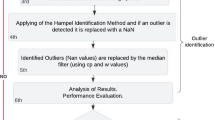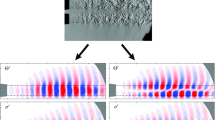Abstract
Outlier (spurious vector) is a common problem in practical velocity field measurement using particle image velocimetry technology (PIV), and it should be validated and replaced by a reliable value. One of the most challenging problems is to correctly label the outliers under the circumstance that measurement noise exists or the flow becomes turbulent. Moreover, the outlier’s cluster occurrence makes it difficult to pick out all the outliers. Most of current methods validate and correct the outliers using local statistical models in a single pass. In this work, a vector field correction (VFC) method is proposed directly from a mixture statistical model of PIV signal. Actually, this problem is formulated as a maximum a posteriori (MAP) estimation of a Bayesian model with hidden/latent variables, labeling the outliers in the original field. The solution of this MAP estimation, i.e., the outlier set and the restored flow field, is optimized iteratively using an expectation–maximization algorithm. We illustrated this VFC method on two kinds of synthetic velocity fields and two kinds of experimental data and demonstrated that it is robust to a very large number of outliers (even up to 60 %). Besides, the proposed VFC method has high accuracy and excellent compatibility for clustered outliers, compared with the state-of-the-art methods. Our VFC algorithm is computationally efficient, and corresponding Matlab code is provided for others to use it. In addition, our approach is general and can be seamlessly extended to three-dimensional-three-component (3D3C) PIV data.














Similar content being viewed by others
Notes
References
Adrian RJ (1991) Particle-imaging techniques for experimental fluid mechanics. Annu Rev Fluid Mech 23(1):261–304
Afanasyev Y, Demirov E (2005) A variational filtration and interpolation technique for PIV employing fluid dynamical constraints. Exp Fluids 39(5):828–835
Bishop CM (2006) Pattern recognition and machine learning. Springer, Berlin
Creutin J, Muste M, Bradley A, Kim S, Kruger A (2003) River gauging using PIV techniques: a proof of concept experiment on the Iowa River. J Hydrol 277(3):182–194
de Baar JH, Percin M, Dwight RP, van Oudheusden BW, Bijl H (2014) Kriging regression of PIV data using a local error estimate. Exp Fluids 55(1):1–13
Deen NG, Willems P, van Sint Annaland M, Kuipers J, Lammertink RG, Kemperman AJ, Wessling M, van der Meer WG (2010) On image pre-processing for PIV of single-and two-phase flows over reflecting objects. Exp Fluids 49(2):525–530
Dempster AP, Laird NM, Rubin DB (1977) Maximum likelihood from incomplete data via the EM algorithm. J R Stat Soc B 39:1–38
Elsinga GE, Scarano F, Wieneke B, van Oudheusden BW (2006) Tomographic particle image velocimetry. Exp Fluids 41(6):933–947
Foucaut J, Carlier J, Stanislas M (2000) Post-processing of PIV records to allow derivative computation. In: Proceedings of 10th international symposium on the applications of laser techniques to fluid mechanics, vol 16. Lisbon, Portugal
Garcia D (2010) Robust smoothing of gridded data in one and higher dimensions with missing values. Comput Stat Data Anal 54(4):1167–1178
Garcia D (2011) A fast all-in-one method for automated post-processing of PIV data. Exp Fluids 50(5):1247–1259
Griffin J, Schultz T, Holman R, Ukeiley LS, Cattafesta LN III (2010) Application of multivariate outlier detection to fluid velocity measurements. Exp Fluids 49(1):305–317
Gunes H, Rist U (2007) Spatial resolution enhancement/smoothing of stereo–particle-image-velocimetry data using proper-orthogonal-decomposition—based and Kriging interpolation methods. Phys Fluids 19(6):064,101
Hart DP (2000) PIV error correction. Exp Fluids 29(1):13–22
Huang H, Dabiri D, Gharib M (1997) On errors of digital particle image velocimetry. Meas Sci Technol 8(12):1427
Liang D, Jiang C, Li Y (2003) Cellular neural network to detect spurious vectors in PIV data. Exp Fluids 34(1):52–62
Liu Z, Jia L, Zheng Y, Zhang Q (2008) Flow-adaptive data validation scheme in PIV. Chem Eng Sci 63(1):1–11
Ma J, Zhao J, Tian J, Yuille AL, Tu Z (2014) Robust point matching via vector field consensus. IEEE Trans Image Process 23(4):1706–1721
Micchelli CA, Pontil M (2005) On learning vector-valued functions. Neural Comput 17(1):177–204
Okamoto K (2003) PIV challenge. http://www.pivchallenge.org/
Pereira F, Stüer H, Graff EC, Gharib M (2006) Two-frame 3D particle tracking. Meas Sci Technol 17(7):1680
Petermeier H, Kowalczyk W, Delgado A, Denz C, Holtmann F (2007) Detection of microorganismic flows by linear and nonlinear optical methods and automatic correction of erroneous images artefacts and moving boundaries in image generating methods by a neuronumerical hybrid implementing the taylors hypothesis as a priori knowledge. Exp Fluids 42(4):611–623
Pope SB (2000) Turbulent flows. Cambridge University Press, Cambridge
Pun CS, Susanto A, Dabiri D (2007) Mode-ratio bootstrapping method for PIV outlier correction. Meas Sci Technol 18(11):3511
Raben SG, Charonko JJ, Vlachos PP (2012) Adaptive gappy proper orthogonal decomposition for particle image velocimetry data reconstruction. Meas Sci Technol 23(2):025,303
Raffel M, Willert C, Wereley S, Kompenhans J (2007) Particle image velocimetry: a practical guide. Springer, Berlin
Schroeder A, Willert CE (2008) Particle image velocimetry: new developments and recent applications, vol 112. Springer Science & Business Media, Berlin
Sciacchitano A, Wieneke B, Scarano F (2013) PIV uncertainty quantification by image matching. Meas Sci Technol 24(4):045,302
Shan F, Fujishiro A, Tsuneyoshi T, Tsuji Y (2014) Effects of flow field on the wall mass transfer rate behind a circular orifice in a round pipe. Int J Heat Mass Transf 73:542–550
Shinneeb A, Bugg J, Balachandar R (2004) Variable threshold outlier identification in PIV data. Meas Sci Technol 15(9):1722
Stanislas M, Okamoto K, Kähler C (2003) Main results of the first international PIV challenge. Meas Sci Technol 14(10):R63
Steinbuck JV, Roberts PL, Troy CD, Horner-Devine AR, Simonet F, Uhlman AH, Jaffe JS, Monismith SG, Franks PJ (2010) An autonomous open-ocean stereoscopic PIV profiler. J Atmos Ocean Technol 27(8):1362–1380
Sugii Y, Nishio S, Okamoto K (2002) In vivo PIV measurement of red blood cell velocity field in microvessels considering mesentery motion. Physiol Meas 23(2):403
Vennemann P (2009) JPIV. http://www.jpiv.vennemann-online.de/
Vennemann P (2008) Particle image velocimetry for microscale blood flow measurement. Delft University of Technology, TU Delft
Vlasenko A, Steele EC, Nimmo-Smith WAM (2015) A physics-enabled flow restoration algorithm for sparse PIV and PTV measurements. Meas Sci Technol 26(6):065,301
Wang Z, Bovik AC, Sheikh HR, Simoncelli EP (2004) Image quality assessment: from error visibility to structural similarity. IEEE Trans Image Process 13(4):600–612
Wang H, Gao Q, Feng L, Wei R, Wang J (2015) Proper orthogonal decomposition based outlier correction for PIV data. Exp Fluids 56(2):1–15
Wereley ST, Meinhart CD (2010) Recent advances in micro-particle image velocimetry. Annu Rev Fluid Mech 42:557–576
Westerweel J (1994) Efficient detection of spurious vectors in particle image velocimetry data. Exp Fluids 16(3–4):236–247
Westerweel J, Scarano F (2005) Universal outlier detection for PIV data. Exp Fluids 39(6):1096–1100
Willert CE, Gharib M (1997) The interaction of spatially modulated vortex pairs with free surfaces. J Fluid Mech 345:227–250
Yuille AL (1990) Generalized deformable models, statistical physics, and matching problems. Neural Comput 2(1):1–24
Zhu Y, Yuan H, Zhang C, Lee C (2013) Image-preprocessing method for near-wall particle image velocimetry (PIV) image interrogation with very large in-plane displacement. Meas Sci Technol 24(12):125,302
Author information
Authors and Affiliations
Corresponding author
Additional information
This article has been retracted by the Editors-in-Chief of the journal on the authors’ initiative. The reasons for the retraction are a technical mistake by the authors and substantial overlap of text with the previous publications Ma J, Zhao J, Tian J, Yuille AL, Tu Z (2014) Robust point matching via vector field consensus. IEEE Trans Image Process 23(4):1706–1721 and Garcia D (2011) A fast all-in-one method for automated post-processing of PIV data. Exp Fluids 50(5):1247–1259.
An erratum to this article can be found online at http://dx.doi.org/10.1007/s00348-016-2202-0.
Appendix: The derivation of EM algorithm
Appendix: The derivation of EM algorithm
It is very difficult to find the closed-form solution to this minimization problem (Eq. 9). As a typical iterative method, the expectation–maximization framework alternates constructing an upper bound and minimizing this bound, and thus provides a numerical solution. Here, we use Jensen’s inequality to construct the upper bound. \((\mathsf {E}(\varphi (X))\le \varphi (\mathsf {E} (X))\), where \(\varphi\) is a concave function, and \(\mathsf {E}\) is the expectation in probability theory.)
where \(E(\varvec{\theta })\) is the negative log posterior function and \(\mathscr {Q}( \varvec{\theta })\) denotes the complete-data log posterior. We just change the position of sum operation and ln function to make the formula tractable. When a certain condition has been reached, the inequality will become equal. The condition is
i.e.,
The expectation step (E-step) result is thus got from this condition. The Eq. 11 is the specific form with probability substitution.
As the \(p(z_i|\mathbf x _i,\mathbf v _i,\varvec{\theta })\) is determined in E-step, the complete-data log posterior should be expressed more precisely with symbol \(\varvec{\theta }^\mathrm{old}\).
The Eq. 10 is the expansion of this equation, and we omit some terms that are independent of \(\varvec{\theta }\). For a complete derivative process, refer to the author’s personal research Web site.
About this article
Cite this article
Lee, Y., Yang, H. & Yin, Z. RETRACTED ARTICLE: A robust vector field correction method via a mixture statistical model of PIV signal. Exp Fluids 57, 31 (2016). https://doi.org/10.1007/s00348-016-2115-y
Received:
Revised:
Accepted:
Published:
DOI: https://doi.org/10.1007/s00348-016-2115-y




